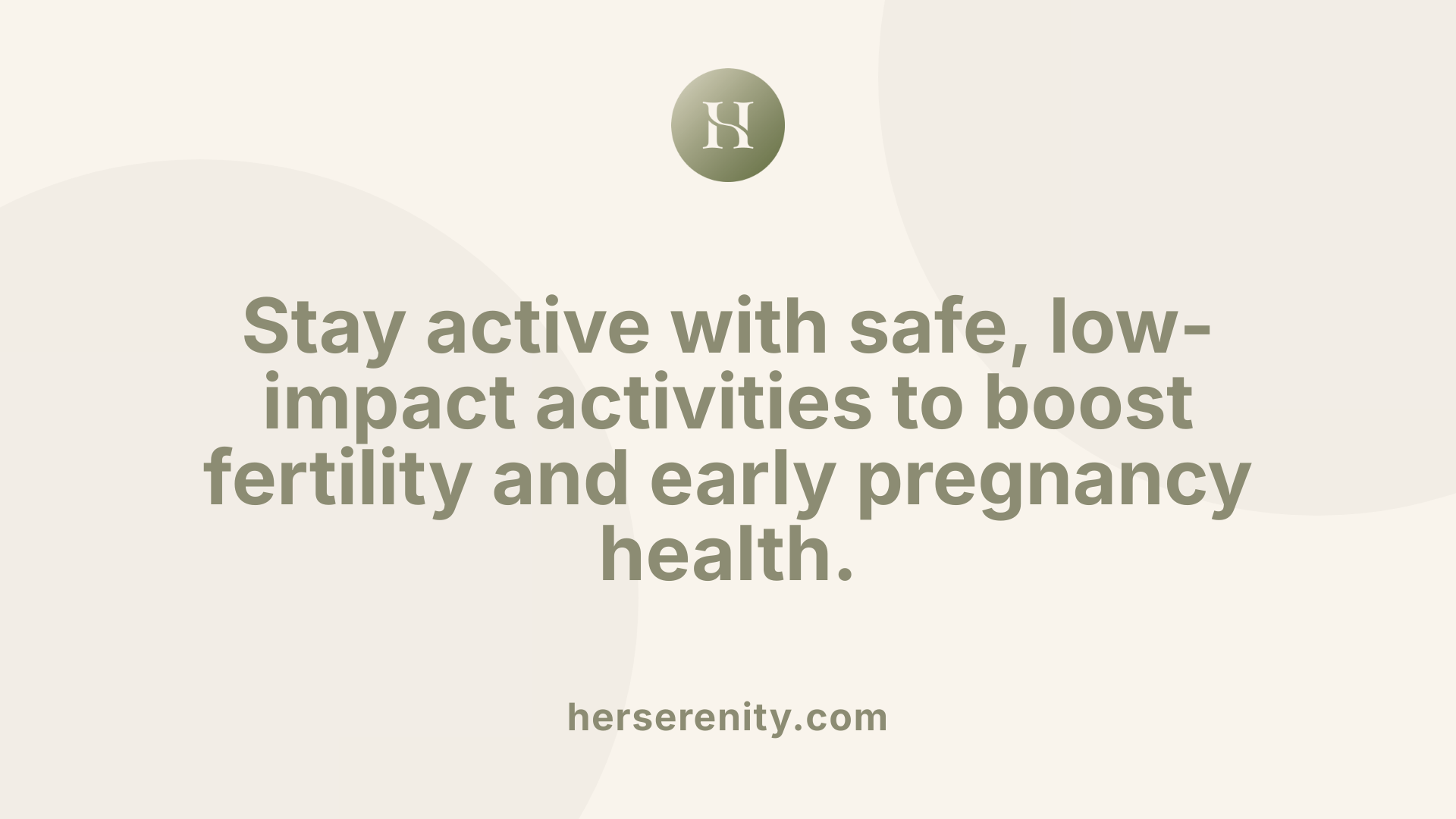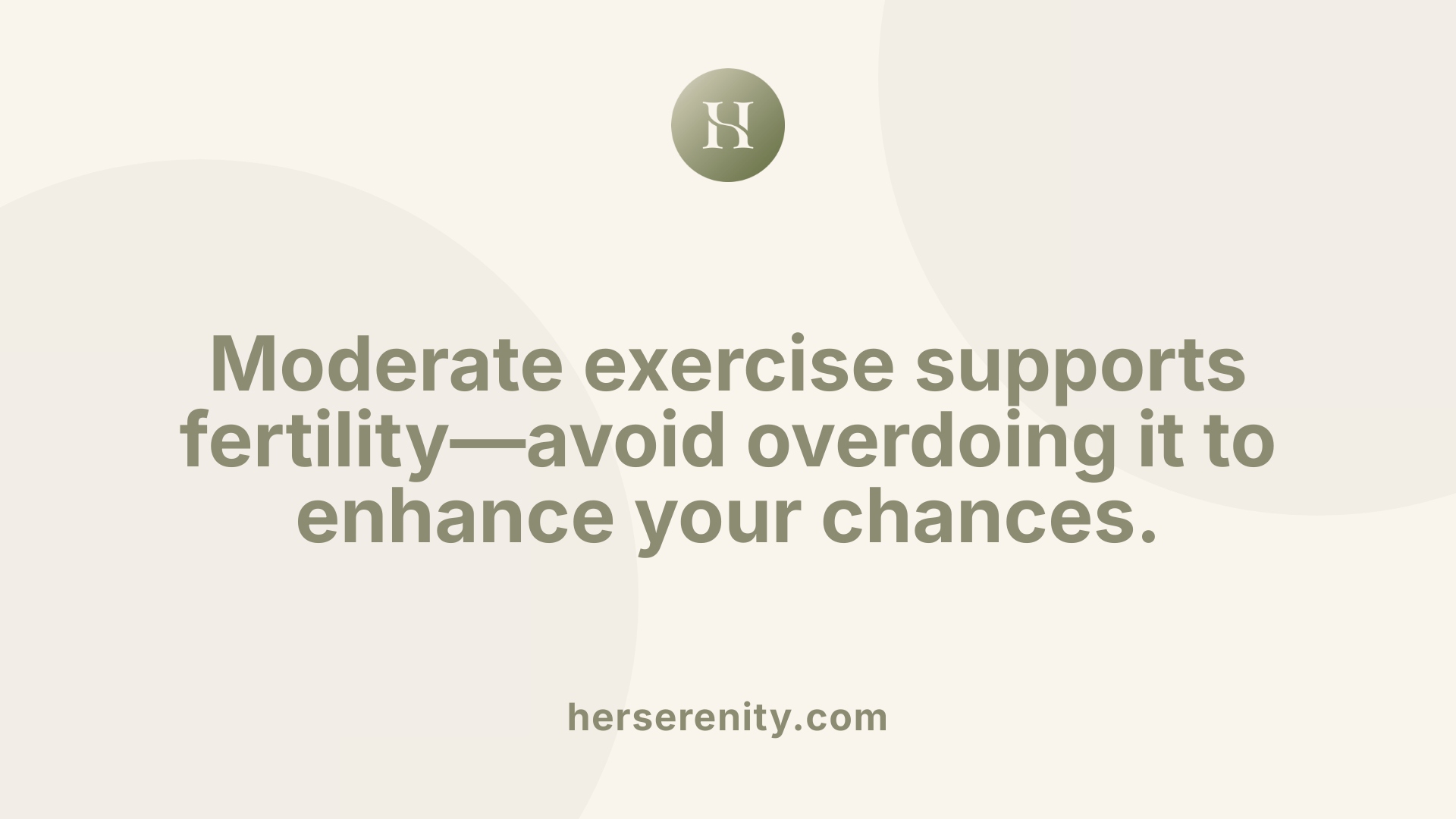The Connection Between Physical Activity and Fertility
Exercise plays a crucial role in maintaining overall health and can significantly influence reproductive health. While moderate physical activity is generally beneficial for fertility, both excessive training and very low activity levels can have adverse effects. This article explores how exercise impacts ovulation and implantation, offering guidance for women trying to conceive and during early pregnancy.
Impact of Exercise on Menstrual Cycle Regularity and Ovulation

Does physical activity impact menstrual cycle regularity or ovulation?
Exercise can have a significant effect on a woman's menstrual cycle and ovulation patterns. Engaging in an appropriate level of physical activity supports hormonal regulation and helps maintain a regular cycle. Moderate exercise, such as walking, swimming, or yoga for at least 30 minutes daily, has been shown to promote hormonal balance, improve blood circulation, and reduce stress, all of which are beneficial for ovulation and cycle regularity.
However, when exercise becomes excessive or intense—typically exceeding four to six hours of vigorous activity per week—it can disrupt hormonal signals. This level of physical stress may lead to menstrual irregularities such as amenorrhea (absence of periods), oligomenorrhea (infrequent periods), or luteal phase defects, which can hinder ovulation and reduce fertility chances.
Most research indicates that moderate, consistent physical activity generally does not negatively impact reproductive health. Instead, it may help normalize menstrual cycles, especially in women with conditions like polycystic ovary syndrome (PCOS). Conversely, extremes in exercise intensity and duration can cause energy deficits that interfere with the hypothalamic-pituitary-ovarian axis—the hormonal system regulating ovulation.
Effects of extreme exercise on ovulation
Extreme levels of physical activity, such as long-distance running, high-impact aerobics, or intensive resistance training, can induce hormonal alterations. These include a decrease in estrogen and progesterone levels due to suppressed hypothalamic function, resulting in irregular or absent ovulation.
Such hormonal disruptions often lead to conditions like functional hypothalamic amenorrhea, which impairs reproductive capability. Moreover, excessively vigorous activity can shorten the luteal phase—the post-ovulation part of the menstrual cycle—posing additional challenges for successful implantation.
In women with low body weight or low body fat percentage, vigorous exercise can exacerbate weight loss, further impairing hormonal balance. Therefore, women trying to conceive should aim for a balanced approach to exercise—moderate in intensity and duration—to support their reproductive health.
Practical considerations
Women should pay attention to their body signals and avoid overexertion, especially during the fertile window. Consulting healthcare professionals can help tailor exercise routines to individual needs, ensuring they support rather than hinder fertility. Incorporating a variety of moderate activities like yoga, brisk walking, or swimming can optimize reproductive health without incurring the risks associated with excessive exercise.
Furthermore, understanding the different phases of the menstrual cycle can guide women in adjusting their workout intensity. During the ovulatory phase, body hormone levels naturally rise, and moderate exercise is usually not a concern. During the luteal phase, opting for lighter activities can help prevent luteal phase shortening and promote a healthier environment for conception.
Overall, maintaining a healthy, balanced exercise routine is vital for optimizing menstrual cycle regularity and improving fertility outcomes.
Exercise During Ovulation and Implantation: Impacts and Recommendations

Can exercise during ovulation or implantation affect fertility or pregnancy?
Exercise during critical fertility windows, such as ovulation and implantation, can have significant effects depending on the intensity and timing of activity. Moderate physical activity generally supports the body's hormonal balance and enhances factors like insulin sensitivity, which can promote regular ovulation. This is especially beneficial for women with conditions like polycystic ovary syndrome (PCOS), helping improve their chances of conceiving.
However, engaging in vigorous or excessive exercise—particularly when combined with a caloric deficit—may disrupt menstrual cycles and lead to issues such as anovulation, where ovulation does not occur. Such disturbances diminish the likelihood of conception and can negatively influence fertilization. During the implantation phase, which occurs during the luteal phase after ovulation, highly intense exercise might hinder the process by reducing blood flow or causing physical stress that interferes with embryo attachment.
Research indicates that light to moderate exercise is generally safe during ovulation and the implantation period, with potential benefits for pregnancy outcomes. Conversely, strenuous workouts, especially those exceeding 60 minutes daily or involving high-impact activities, should be approached cautiously. Adjusting activity levels and avoiding overexertion during these sensitive periods can help optimize fertility and support early pregnancy.
In summary, a balanced exercise routine tailored to individual health and fertility conditions promotes better reproductive health. Women trying to conceive should prioritize moderate activities like walking, swimming, or yoga during ovulation and implantation to help support their fertility goals.
Guidelines for Exercise When Trying to Conceive or in Early Pregnancy

What are the guidelines for exercise when trying to conceive or during early pregnancy?
For women aiming to conceive or in the initial stages of pregnancy, engaging in moderate, low-impact exercises is highly recommended. Activities such as walking, swimming, yoga, and Pilates help improve overall health, support hormonal balance, and promote efficient blood circulation to reproductive organs. These exercises also aid in reducing stress, which is beneficial for fertility.
It is advised to aim for at least 150 minutes of moderate-intensity activity spread throughout the week. Breaking this into manageable sessions, like 30 minutes most days, makes it easier to maintain consistency. During exercise, women should listen to their bodies, avoiding activities that cause discomfort, dizziness, or pain.
High-impact sports, contact sports, or activities with a high risk of falling or overheating should be avoided. This includes activities like strenuous running, heavy weightlifting, and high-impact aerobics. Additionally, after 16 weeks of pregnancy, lying flat on the back should be avoided to prevent compressing major blood vessels, which can reduce blood flow to the fetus.
Hydration is critical; drinking plenty of water before, during, and after exercise helps prevent dehydration. Women should also steer clear of exercises that cause excessive fatigue or raise body temperature too high.
Monitoring for symptoms such as bleeding, dizziness, or unusual pain is crucial. If any adverse symptoms occur, exercise should be stopped immediately.
Consulting with healthcare providers or qualified fitness instructors can help tailor a safe, effective exercise plan suited to individual needs and pregnancy progression. The overall goal is to stay active in a safe and enjoyable manner, supporting both fertility and early pregnancy health.
Exercise and Fertility Treatments: Effects and Considerations
Can exercise influence IVF success or fertility treatments?
Exercise can play a role in the outcomes of IVF and other fertility treatments, but its effects are influenced by factors such as timing, intensity, and individual health conditions. Moderate physical activity, including walking, yoga, swimming, and gentle Pilates, supports overall well-being and can improve blood circulation, hormone balance, and stress levels.
During IVF cycles, particularly around important stages like ovarian stimulation and embryo transfer, activity levels should be carefully managed. It is generally recommended to avoid high-impact or strenuous exercises during the week of egg retrieval and after embryo transfer, as vigorous activity might increase risks such as ovarian torsion and could interfere with implantation.
Research suggests that engaging in regular, moderate exercise prior to starting IVF may enhance success rates, especially in women with a normal weight. Conversely, excessive or overly intense workouts—such as long-duration running, CrossFit, or high-impact cardio—may reduce the chances of conception and negatively affect ovarian function.
Consulting with a healthcare provider is essential for creating a personalized exercise plan aligned with individual conditions and treatment stages. Such tailored plans help optimize fertility outcomes by balancing physical activity with the body's needs during this sensitive period.
Overall, moderate exercise supports physical and emotional resilience during fertility treatments, but overexertion should be avoided to maximize success.
Common Misconceptions About Exercise and Fertility

Are there misconceptions about exercise and fertility I should be aware of?
Yes, misconceptions regarding how exercise affects fertility are quite common. Many people think that any physical activity, especially strenuous workouts, might negatively influence their chances of conception. However, the reality is more nuanced.
Research shows that moderate exercise—around 30 minutes most days of the week—can actually support fertility. Activities like walking, swimming, yoga, and Pilates help maintain a healthy weight, balance hormones, reduce stress, and improve blood flow to reproductive organs. These benefits can enhance ovulation, especially in women with conditions like polycystic ovary syndrome (PCOS), and support overall reproductive health.
On the other hand, excessive or high-intensity exercise exceeding about 4 to 7 hours per week may interfere with hormonal balance and ovulation. For example, activities that significantly raise body temperature or induce caloric deficits—such as hot yoga, marathon running, or CrossFit—can disrupt menstrual cycles and reduce sperm quality in men.
It's important to understand that overexercising can lead to lowered progesterone levels, shortened luteal phases, or menstrual irregularities, all of which can hinder conception efforts. Conversely, too little activity or sedentary lifestyles pose their own challenges, including obesity, which is associated with infertility.
Overall, the best approach is personalized. Consulting healthcare professionals can help tailor exercise routines that optimize fertility—emphasizing moderation while avoiding excessive exertion. By doing so, individuals can support their reproductive health and increase their likelihood of conception.
In summary, moderate physical activity is generally beneficial, while overdoing it can have the opposite effect. Being informed and cautious about exercise routines ensures a healthy balance that promotes fertility rather than impedes it.
Activities to Avoid Around Ovulation and During Implantation

What activities should I avoid around ovulation or during the implantation window?
During the periods around ovulation and implantation, it is important to pay attention to the type and intensity of physical activities. Vigorous or strenuous exercises should be minimized or avoided altogether during these sensitive times.
Activities like intense running, high-impact aerobics, heavy weightlifting, and sports involving jumps or bouncing can disrupt hormonal balance and potentially interfere with the implantation process. These high-impact exercises increase intra-abdominal pressure and may cause physical stress, both of which can have adverse effects on fertility.
In contrast, moderate activities such as walking, swimming, gentle yoga, or light cycling are considered safe and may even support reproductive health by helping to maintain a healthy weight and reducing stress levels.
It’s advisable to steer clear of activities that involve abdominal trauma, rapid changes in direction, twisting motions, or extensive jumping, as these could lead to injury or create an environment less conducive to implantation.
After embryo transfer during assisted reproductive treatments, exercise should be paused until pregnancy is confirmed and your healthcare provider gives clearance. Continuing high-impact or vigorous activities during this period could jeopardize successful implantation.
In summary, during ovulation and implantation, gentle, moderate exercises are recommended. They foster a supportive environment for conception without risking physical stress or injury. Consult your healthcare professional to tailor activities that best suit your individual circumstances, ensuring a safe and supportive approach during these crucial stages.
Balancing Exercise and Fertility Goals
Maintaining a balanced exercise routine tailored to individual needs and circumstances is essential for supporting fertility and optimizing the chances of conception and successful implantation. Moderate activities that promote hormonal balance, reduce stress, and support a healthy weight are most beneficial, whereas excessive vigorous exercise can pose risks to reproductive health. Women should listen to their bodies, consult healthcare professionals, and prioritize consistency and moderation during their fertility journey. Properly managed, exercise can be a powerful tool not only for overall well-being but also for enhancing fertility outcomes.
References
- How safe is exercise while trying to conceive? - Clearblue
- The effect of physical activity on fertility: a mini-review - PMC
- Exercise During Ovulation and Implantation: Need-to-Knows
- What to Know about Exercise and Fertility - New Hope Fertility
- We Explore How Can Exercise Affect Fertility and More
- IVF and Exercise: How Working Out Influences Outcomes
- What the Research Says About Exercise, Fertility, and Pregnancy | Ro
- Trying To Conceive? Exercise Guidelines For The 2 Week Wait Period





